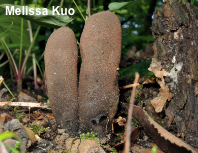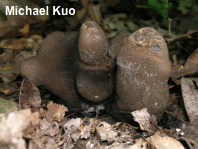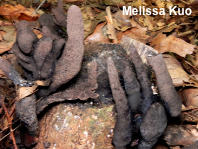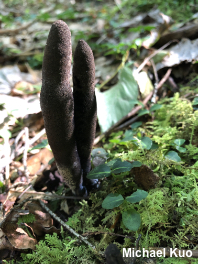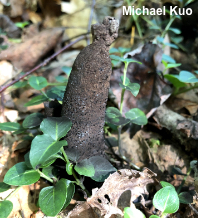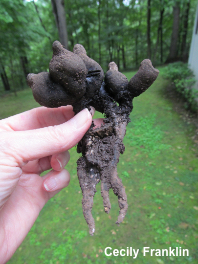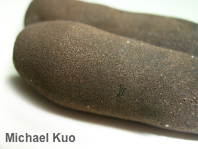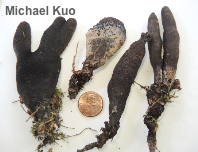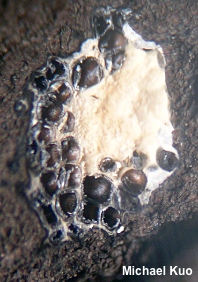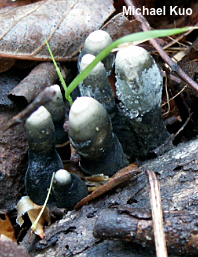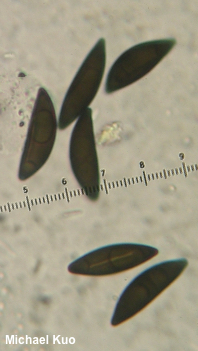| Major Groups > Clubs & Corals > Xylaria > Xylaria polymorpha |

|
Xylaria polymorpha [ Ascomycota > Sordariomycetes > Xylariales > Xylariaceae > Xylaria . . . ] by Michael Kuo Sometimes called "dead man's fingers," this odd mushroom dons a couple of costumes in its rather long life span. When young it is pale (often bluish), with a whitish tip; the pale covering is a coating of asexual spores produced in this early stage of development. Morel hunters frequently encounter Xylaria polymorpha in this form, in early spring. By summer, however, the mushroom begins to blacken, and by late summer or fall it reaches maturity, when pimple-like, sexual, spore-producing perithecia are embedded just below the now dark brown to black surface. Somewhere in the middle of this progressive costume change, Xylaria polymorpha does indeed look like a creepy set of "dead man's fingers." By the final stages, however, one is more likely to mistake it for something, um, left by a house cat a long time ago. Xylaria polymorpha is the most commonly collected of the large Xylaria species, but the species name is often applied in a broad sense, encompassing several species that are differentiated primarily on microscopic features. In the strictest sense, Xylaria polymorpha should have spores 20–28 µm long, with a straight or slightly slanted vertical line (a "germ slit"). Similar species (for example Xylaria longipes) have much shorter spores or, in the case of Xylaria schweinitzii, spores that are similar in length but feature germ slits that curve around the spore. Rogers and Callan (1986) document two "common morphological variants" of Xylaria polymorpha in the United States: a dull black, northeastern and upper Midwestern form, and a more brown, southern and lower Midwestern form (probably the form featured here, given the collection locations and colors of the fruiting bodies). Unfortunately for would-be identifiers, the best way to separate the two forms is to attempt to culture them in the lab; the northern, black form cultures easily, while the southern, brownish-black form does not. Whether or not these two forms of the fungus constitute separate species remains to be investigated with contemporary methods. Thanks to Cecily Franklin for collecting, documenting, and preserving Xylaria polymorpha for study; her collection is deposited in The Herbarium of Michael Kuo. Thanks also to Sherwood Forest Friends for facilitating collection of specimens. Description: Ecology: Saprobic on decaying hardwood stumps and logs, usually at or near the base of the stump; sometimes appearing terrestrial but actually attached to buried wood; growing alone or, more commonly, in clusters; causing a soft rot of the wood; appearing in spring and not decaying until late summer or fall. Widely distributed and common in North America from the Rocky Mountains eastward (but see the discussion above regarding northern and southern "forms"). The illustrated and described collections are from Illinois, North Carolina, and Pennsylvania. Immature Fruiting Body: Usually more or less club-shaped, with a bluntly narrowed, white tip; elsewhere pale to dark gray, often with a bluish or purplish zone; surface finely dusted, smooth, dry; interior flesh white and tough. Mature Fruiting Body: 4–14 cm tall; 1–3 cm thick (sometimes up to 5.5 cm thick when irregularly shaped); usually shaped more or less like a club, with a rounded tip, but often irregular (flattened, swollen toward the top or bottom, or even lobed); dark brown to black; surface dry, often finely scaly and/or pimply, and sometimes finely wrinkled; tapering pseudostem rooting into the substrate, black and fuzzy, up to 7 cm long; interior flesh white and very tough; perithecia up to about 1 mm across, spherical, submerged just below the surface. Odor: Not distinctive. Microscopic Features: Spores 24–28 x 6–8 µm; elongated-fusiform, often with a "banana" end; smooth; dark brown and biguttulate in water; with a thin, pale, straight or slightly oblique germ slit that runs more than half the length of the spore. Asci 8-spored. Conidia to 7.5 x 4 µm; elongated-lacrymoid to ellipsoid, with an apiculate end; smooth; hyaline in water; thin-walled. REFERENCES: (Persoon, 1797) Greville, 1824. (Saccardo, 1882; Dennis, 1968; Smith, Smith & Weber, 1981; Breitenbach & Kränzlin, 1984; Arora, 1986; Rogers, 1986; Rogers & Callan, 1986; Phillips, 1991/2005; Lincoff, 1992; Metzler & Metzler, 1992; Horn, Kay & Abel, 1993; Barron, 1999; Roody, 2003; McNeil, 2006; Miller & Miller, 2006; Rogers, Miller & Vasilyeva, 2008; Kuo & Methven, 2010; Kuo & Methven, 2014; Woehrel & Light, 2017; Becerril-Navarrete et al., 2018; Elliott & Stephenson, 2018; Sturgeon, 2018.) Herb. Kuo 05010302, 07120811, 10100901, 07111001, 07051102, 06271502, 09061701, 08091907. This site contains no information about the edibility or toxicity of mushrooms. |
© MushroomExpert.Com |
|
Cite this page as: Kuo, M. (2019, October). Xylaria polymorpha. Retrieved from the MushroomExpert.Com Web site: http://www.mushroomexpert.com/xylaria_polymorpha.html |
